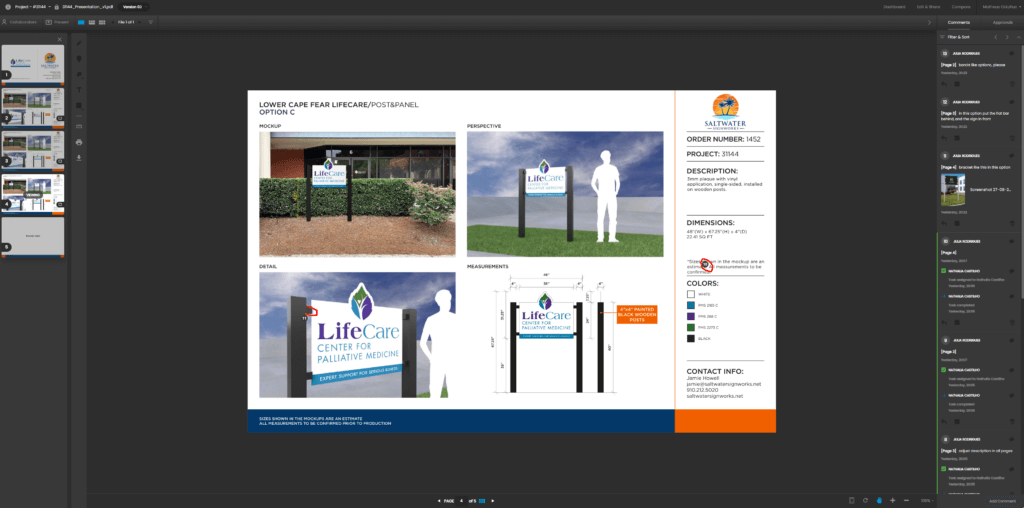It’s a reality of the remote and hybrid workforce that you’ll be working across time zones. And that presents a range of challenges in a high-paced and high-volume environment.
How do you enable designers on opposite sides of the world to effectively collaborate? How can you get transparent client feedback and get tasks done with very fast turnarounds?
The right tools for collaborative feedback is essential.
We asked Matheus Ostafiuc and Ricardo Trzmielina, managing partners at The Sign Pack, to share how ReviewStudio has enabled their review and approval process. With around 250 deliverables to meet daily, they estimate that this would be untenable without ReviewStudio helping to save them on average an hour per project per day.
Here’s how The Sign Pack uses ReviewStudio to save thousands of hours a month.
Daniela – Sign design is quite a niche! How did you get into this area? Can you tell us a bit about The Sign Pack – what makes your offering unique in the industry?
Matheus & Ricardo – We started out as a sign company in Boca Raton, in South Florida. We were simply a regular local sign shop.
One of the key challenges we faced was the graphic design element. Sign design has very specific challenges – you need to make something that looks good, but is also practical from a manufacturing perspective.
We were finding it difficult to build a scalable design team. Most of the new designers are focused on digital video games or motion design. We saw this as an opportunity in the market. We took our know-how in sign production and developed a full-service sign design agency. And we now design for sign companies.

Can you tell us about the design process that you go through for your sign projects? How does designing from both a design and a manufacturing perspective make what you do unique?
We start with a technical design that works on three fronts: the environment, the brand, and the manufacturer.
The last part is especially tricky. Usually, companies struggle because they might get a really creative designer who develops a great campaign concept. But when it comes to designing it to fit their production needs, it doesn’t work.
Meanwhile, the customer has already approved the design.
What we do is unique. We provide the graphic design services that fit not only the visual aspects of the statics but also with the manufacturing needs.
So, whether it is a large monument or a hospital that is being rebranded, our design will fit the static needs, marketing needs, and, critically, the technical requirements for fabrication.
Your service offering seems to rely heavily on workflows. How do you manage workflow challenges for your clients?
We have a large team spread out across the globe. We have a team of about 75 designers now, with a large team in Brazil as well as in Colombia and Chile. We also have small teams in Angola, Poland, and Indonesia. We aim to provide a design production factory that never sleeps.
We start by providing our customers with creative layouts, once approved, we make the fabrication drawings, as well.
When we send the design to clients, we will need to receive feedback. Getting that feedback is one of the things that’s ReviewStudio really helps us with.
When requests are submitted to one of our teams, there’s a lot of efficiency with a quick project turnaround. Rather than our customers having a backlog of two weeks, we’ve been able to turn around the layouts within 48 hours.
With the time sensitive workflows that you have, I can imagine proofing used to be a bit of a nightmare. How were you previously gathering feedback and approvals on designs?
Without ReviewStudio, this wouldn’t be possible.
One of the essential benefits we offer our customers is the accuracy of our designs. A lot of the feedback that we need to receive about the deliverables is very specific and requires precision.
It’s the kind of thing that you cannot do in a call.
With a project with 30 different measurements, with a particular one that needs to be adjusted, it’s a must to have precise mark-ups of what has to be done.
Are there any other specific features within ReviewStudio, aside from the accurate markup tools, that might have helped you, or you’ve noticed provide a lot of value?
The ability to manage versioning is essential. It really helps preserve the history of projects. This is something that has not only helped us communicate with clients but helps us internally to understand where each project stands.
Another feature that I think is really beneficial to our clients is the compare mode. Let’s say that Designer A did version 1 and then there was a problem and Designer B went there to fix it. We can use compare mode to show the difference. It’s also beneficial for training our internal users.
Something that we recently implemented in our workflow is the tasks. One project had 132 comments. It can be really difficult for the designer to take that many comments under review, and they sometimes forget one or miss one. So, we assign the task to the designer who is handling the project. That way the coordinator can see if everything is done, or if there are any questions.
On your website, you talk about promising quality design, efficient workflows, and bottom line. How does ReviewStudio help deliver on these promises?
Going back a little to the internal communication perspective, I think ReviewStudio really helps us monitor how we are improving. We have all the design work in one place, organized by clients.
As we are receiving the feedback, and especially as a remote-first company, our whole team can see the revisions. When we want to flag a project, everybody can see and access the comments.
For example, if a coordinator in Brazil is handling the project but the designer is in Indonesia, the coordinator can make annotations and highlight changes that are needed before submitting to clients.
It helps to centralize information internally – which really helps us improve.
And in terms of revenue, besides the benefits that come with clear and centralized feedback on the quality of creative, it presents a professional image for our clients. It gives us credibility as well, which helps us to be more efficient and focus on revenues and fewer revisions.
So, greater productivity across your team. Are there any specifics that come to mind?
I think that we do at least on average nowadays about 200 to 250 deliverables every day. Some are new projects, some are revisions, some are production files.
ReviewStudio saves us a minimum of 1 hour per project, since all projects go through internal review and proofreading. Once a designer uploads them, we will have a coordinator who checks and reviews the design. If it needs changes, it’s easy for the team lead to review projects. It’s easy to communicate what has to be changed.
Then it goes to the clients. Nobody needs to be waiting by the phone or for clients to tell us what has to be changed. When we receive a notification, the designer is notified, and the revisions are made.
So, conservatively, that saves us at least an hour per project.
That’s a lot of time saved. If that comes out to between 200 and 250 hours per day, that’s a phenomenal return. Do you think you’ve won new business because you are using ReviewStudio?
I’m not sure if ReviewStudio helped us to win new accounts, but it’s definitely helped us to keep the accounts that we win. ReviewStudio really helps us with loyalty, keeping churn low.
Overall, it’s something that helps us so much both internally and externally for clients, in terms of efficiency. Because you know, at the end of the day, the more quality designs we deliver, the more profitable we are. ReviewStudio helps our designers deliver more efficiently and then at the same time, we have the perfect tool to help us communicate effectively with our clients.
Everything just fits our needs.
The client feedback has been always really positive. Most of our clients, after the first time using ReviewStudio, will be fully integrated. It’s very intuitive. The feedback has been that everybody can use the system with ease.
That’s great to hear. Do you have any advice for someone starting with ReviewStudio or online proofing in general?
The first step is to have a conversation with clients. You can use the tutorial for new users and guests, but we always try to show clients the ins and outs of how it works.
This way they are familiarized with what they can do – downloading files, making annotations, explaining to guest users how they can make comments and so on – the way we will need them to use it.






